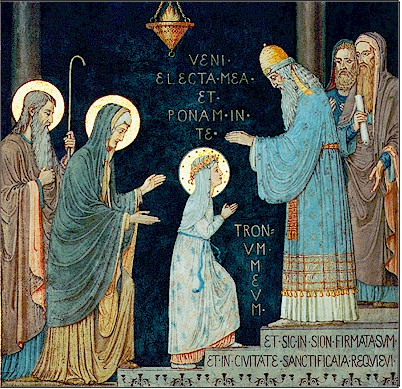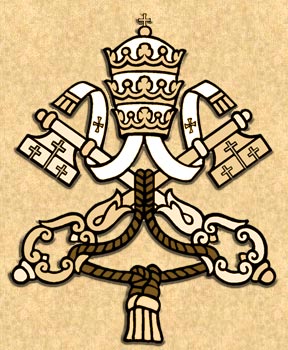
The Scriptures tells us nothing of Mary's hidden life. The inspired Word of God gives us no word about her Presentation in the Temple, the feast which we celebrate each year on November 21st. However, we do have the testimonies of tradition which are based on accounts which come to us from apostolic times. That which is known about the Presentation of the Blessed Virgin Mary in the Temple is found in the Apocrypha, principally in chapter seven of the Protoevangelium of James, which has been dated by historians prior to the year 200 AD.
This book gives us a detailed account in which Mary's father, Joachim, tells Anna his wife that he wishes to bring their child to the Temple of the Lord. Anna responds that they should wait until the child is three years old lest she yearn for her parents. When the day arrived, the undefiled daughters of the Hebrews were invited to accompany Mary with their lamps burning to the Temple. There the priest received her, blessed her, and kissed her in welcome. He proclaimed, "The Lord has magnified thy name in all generations. In thee, the Lord will manifest His redemption to the sons of Israel." Mary was placed on the third step of the Temple and there danced with joy and all the house of Israel loved her. It was there that she was nurtured and her parents returned, glorifying the Almighty.
Historians tell us that the Emperor Justinian built a splendid church dedicated to Mary in the Temple area in Jerusalem. It was dedicated on November 21, 543 but was destroyed by the Persians within a century. Many of the early church Fathers such as St. Germanus, Patriarch of Constantinople (+730) and St. John Damascene, his contemporary, preached magnificent homilies on this feast referring to Mary as that special plant or flower which was being nurtured for better things." She was planted in the House of God, nourished by the Holy Spirit and kept her body and soul spotless to receive God in her bosom. He Who is all-holy rests among the holy."
Pope Paul VI in the 1974 encyclical Marialis Cultus, n.8, wrote of this feast that "despite its apocryphal content, it presents lofty and exemplary values and carries on the venerable traditions having their origins in the Eastern churches."
(Courtesy http://campus.udayton.edu/mary/meditations/Nov21.html )









No comments:
Post a Comment